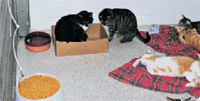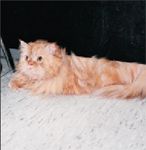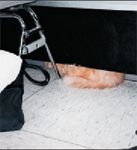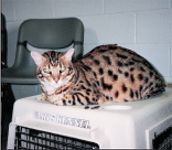Feline communication: Integrate the sign into a strategy
The final column in this series on feline communication focuses on integrating all the signals we have discussed and in reviewing their roles given the context of the specific behavioral environment.
The final column in this series on feline communication focuses on integrating all the signals we have discussed and in reviewing their roles given the context of the specific behavioral environment.
Social interactions are not all-or-nothing situations; they are negotiated and nuanced dances. In Photo 1, the cat is settled in the most simple of environmental enrichment tools — the cardboard box. This box is sufficiently snug that the cat can rest his head against one end and still monitor the cats in the surrounding social swirl. The position of the cat's ears and his pupil size suggest that this cat is fairly alert, but he is not reactive. By virtue of being in an enclosed space, he has removed himself from active social behavior at this point in time, and by virtue of his ability to monitor such social interaction, he maintains control over his ability to change his mind. Both of these behaviors — taking yourself out of the social milieu in a manner that permits some form of "hiding" and maintaining control over your decisions — minimizes stress that cats can feel. In fact, early papers on stress in laboratory cats showed that having the ability to hide reduced physiological stress, and that enhanced physiological stress was associated with thwarted attempts to hide. So, having some ability to control either your environment or your response to your environment is important for a behaviorally healthy cat.

Photo 1: Removed from active social behavior, this cat is still on alert.
If we look at Photo 2, we see what happens 10 minutes later when this cat decides he wants to move. We also see the broader social environment. Here the black-and-white cat has made the decision to get up. From a sitting position, he can either re-adjust his posture in the box, or he could leave the box. However, he is not making this decision in a social vacuum; another cat awaits the potential opportunity to use the box. Here's where the negotiated dance is so important.

Photo 2: From a sitting position, this cat still has choices on how it will react to new interactions.
Positioning keys
First, notice the similarity in body postures for these cats; they are almost mirror images of each other. Second, notice that both cats appear to be taking great pains to signal that neither is a threat. Their ears are forward, showing that they are alert. Their coats are smooth; they are partially hunched down without rapidly lashing tails, and they are both looking off into the distance. When you combine these behaviors with the fact that each cat is positioned so that each has his or her neck turned away from the other, which is a deferential behavior in all social species under examination, and that they are looking toward the floor, it becomes clear that neither cat wishes any overt challenge or contest to occur.
The black-and-white cat has full control of the box. The tabby has signaled that she, too, would like to use the box. These signals are not lost on the rest of the cat colony: Most of the cats are watching these two. In short, when the black-and-white cat signaled a potential change in posture and decision, the tabby asked for information about whether she could occupy the box.
When humans ask questions, they do so in words. We also often put ourselves in physical positions that get us more information. When dogs and cats ask questions, they do so by a series of behavioral changes that are sometimes provocative. Sentient species always act to gain information that will allow them to make decisions about how to use their time and other resources. If we wish to understand cat signaling, we must accept fully what this means.
Key observations
Cats who are less confident or comfortable in their interactions may not do such a good job of asking questions directly. These cats often get their information passively, by observation. They then decide whether they wish to engage in the social interaction or group. One of the features that unite extremely anxious dogs and cats is that part of their pathology prohibits them from efficiently using information. These animals cannot get information passively because they are too reactive to step back and watch what is contextually unveiling. They are also not good at getting information actively because in the process of doing so they actually provoke the social environment and may only be able to process very extreme responses. Of course, with time, such cats tend to induce only extreme responses. However, the less outgoing cat is able to choose whether to actively or passively seek information, if they have the ability to walk away.

Photo 3: Segregated from the group, this cat continues to actively observe other cat interactions.
In Photo 3, the white cat with black spots has physically segregated herself from the group, but she is actively engaged in obtaining information by observation of the activities that are ongoing in the group.

Photo 4: This cat was just brought into the examination room. The closed positioning tells one a lot about the stress its experiencing.
The fact that she has placed herself in front of an open door is not accidental; it's a corollary of the avoid-and-hide coping strategies that cats use to reduce stress. Yet, she is not hiding; she is monitoring her social world. This can be a normal behavioral phenotype for pet cats, but clients often think these cats are suffering and want them to be more interactive. It's important that clients understand a cat that chooses to segregate in the absence of pursuit may be exhibiting a normal behavior. The cat that is actively hiding as an avoidance behavior — something no one could attribute to the cat in Photo 3 — may be doing so in response to a perceived threat. Clients need to monitor such behaviors in more shy and self-contained cats to ensure that changes in the cat's social environment do not cause suffering.

Photo 5: This cat is showing signs of extreme stress. Notice the dilated pupils and the extended head positioning, showing it is actively monitoring its surroundings.
The role that hiding plays in cats that are brought to veterinary hospitals cannot be over-emphasized. In Photo 4, we see a cat that has just been brought in to the exam room. This cat resembles a furry loaf of bread. His limbs are tucked under his belly; his tail is not apparent because it is plastered tightly around him; his neck is retracted, and his head is tucked. Notice the position as well; he has scooted to the far end of the carrier. When this cat is taken from the carrier and given the choice of spaces to explore in the exam room, he conveys that he feels extremely stressed by his choice of space utilized. In Photo 5 we can see that his tail is still tightly wrapped around his body, and limbs are still tucked. But here, his head is up because he must monitor the environment. His pupils are fully dilated, a pattern that fits with an extremely distressed cat. His hair is spiky, indicating the extent to which he is reactive. Photos 6 and 7 show what happens as the perceived threat (e.g., me) moves closer. The cat withdraws until he is almost inside the radiator cover. He will continue to monitor the environment until he is nearly completely hidden from view. This cat is showcasing a coping mechanism to deal with extreme stress and distress.

Photo 6: The approaching human is signaling this cat to retreat.
Cortisol's role
Early research on laboratory cats showed that when such behaviors occurred, cortisol and other measures of stress were perturbed. High cortisol may affect many values in diagnostic blood panels, especially if they occur as part of a wellness screen. They can also enhance an animal's susceptibilities to infectious disease as well as interfere with an animal's ability to learn complex associations. The latter should concern us because it means that any chance that the cat had of learning that this was for his own good is dashed. On the other hand, cortisol enhances learning about fear and hones fearful reactions.

Photo 7: Even when completely hidden, the cat will continue to actively monitor the room.
These are patterns that we must begin to consider if we are interested in the animal's behavioral wellness as well as its physical health. We must begin to ask where we are doing harm as part of our well-intentioned care of pets and ask if there are better ways to handle such situations.

Photo 8: Even though this cat's eyes are almost closed, the animal is on alert.
Finally, not all animals that experience some kind of stress can deal with it in the same ways. Unfortunately, we do not know if this is because of innate individual or breed differences, or if the range of experiences informs patterns of response differently for cats of different genetic or temperamental backgrounds. I would guess that the latter description is more accurate because, of course, it is more plastic and complex. But breed may also confound personality or temperament types, and the extent to which this is true has become an important question in canine behavioral genetics. In our last set of photos, we see a Bengal cat. In Photo 8, we can appreciate that this cat is exhibiting a very similar behavior posture exhibited by the cat in Photo 4. His limbs are tucked, his tail is tightly curled to fit the conformation of his body; his neck is reclined, and his head is lowered. The slight spikiness in his coat over his hips is also a clue that, although his eyes are closed, he remains reactive, rather than sleepy. Yet, this cat is exhibiting these behaviors in the open on top of the carrier in which he was transported to the clinic. To sit here was clearly the animal's choice. In Photos 9-11, we can see that signs of arousal increase as the clinician approaches the cat. His head comes up, his coat becomes just a little more erect, and his pupils dilate. Look at other behavioral cues (Photo 11). His ears lower; his stare is direct, and his jaw remains clenched. So, we have presented two similar contexts, two similar starting postures and two slightly different outcomes.

Photo 9: The behaviors change as the clinician approaches in this sequence Photos 9-11.
This is the dance of signaling that involves consideration of the context. This cat chose to sit on top of his carrier, so we know that the outcome will change. Interestingly, after many manipulations, when this cat was offered numerous places to withdraw, he chose another high spot (the sink) where he could monitor the actions in the room (Photo 12). He is not under the dish, which could have provided fantastic cover. Few of us would likely move the dish without first announcing our intentions to this very focused and observing feline.

Photo 10 : Notice the positioning and its coat, which became a little more erect.
How much does it matter that this is a Bengal cat, a breed that is routinely bred back to "wild"? We must consider what it means genetically to be so close to such an ancestral background. Interestingly, this cat was brought for a consultation because he exhibits a behavior that quite a few Bengal cats exhibit: they over-groom, and his obsessive focus on two patches (one of which is just visible on his flank in Photo 9) on his skin worsens at times of relative confinement. Chances are such responses also inform how he will react in other contexts.

Photo 11: The animal's ears lower; his stare is direct with clenched jaw as the threat approaches.
Signaling is not simple. In addition to the dance imposed by context, these behaviors have rules, and patterns mean something. As such, it is our first, easiest and most accessible portal into understanding the cat's mind from the cat's viewpoint. We should use it more often.

Photo 12: this cat chose another high spot to monitor its surroundings.